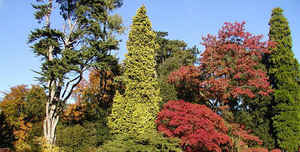New York State Tree
Sugar Maple

(Aceraceae Acer saccharum M.)
Adopted in 1956.
The sugar maple (Aceraceae Acer saccharum,) was adopted as New York State tree in 1956 in recognition of it value.
The sugar maple sometimes called hard maple or rock maple, sugar maple is one of the largest and more important of the hardwoods. Sap from the trunks of sugar maples is used to make maple syrup is our main source of maple syrup made from sap stored in its trunk. Its leaves are pointed and turn bright colors in the fall.
New York State Tree: Sugar Maple

Acer saccharum Marsh. (sugar maple or rock maple) is a species of maple native to the hardwood forests of northeastern North America, from Nova Scotia west through Quebec and southern Ontario to south eastern Manitoba around Lake of the Woods and across the border from Minnesota south to Georgia and Texas. Sugar maple is best known for its bright fall foliage and for being the primary source of maple syrup.
Sugar maple is a magnificent forest tree abundant everywhere in the State outside of Long Island. Besides providing beautiful borders to many miles of highway, and hundreds of thousands of gallons of maple syrup, it yields a wood of high grade. The wood is hard, strong, close-grained, and tough, with a fine, satiny surface. It is in great demand for flooring, veneer, interior finish, furniture, shoe lasts, rollers, and as a fuel wood of the best quality.
Identification of the Sugar Maple

Under optimal growing conditions, sugar maple can attain heights in excess of 100 feet. The largest reported individual was found near Bethany, West Virginia; it had a diameter of 5.6 feet, a crown spread of 75 feet, and a height of 110 feet. Most mature trees, however, range from 70 to 90 feet in height and have diameters at breast height (4.5 feet above the ground) commonly measuring from 2 to 3 feet. Trees grown in the open have trunks that branch near the ground, forming crowns that spread 60 to 80 feet. In contrast, those found in shaded forest conditions normally develop clear, straight boles and narrow crowns.
- Leaf: Opposite, simple and palmately veined, 3 to 6 inches long, 5 lobed with entire margin; green above, paler below.
- Flower: Yellow to green, small, clustered, hanging from a long (1 to 3 inch) stem, appearing with the leaves.
- Fruit: Two-winged horseshoe-shaped samaras about 1 inch long, appearing in clusters, brown when mature in Autumn.
- Twig: Brown, slender and shiny with lighter lenticels, terminal buds brown and very sharp pointed.
- Bark: Variable, but generally grayish brown,on older trees may be furrowed, with long, thick irregular curling outward ridges.
- Form: Medium to tall tree (to 100 feet) with very dense elliptical crown.
Laws of New York
The law designating the sugar maple as the official New York state tree is found in the New York State Consolidated Laws, STL, Article 6, Section 76.
Laws of New York
STL State
Article 6 - ARMS AND GREAT SEAL OF STATE
§ 76. State tree. The sugar maple (Acer Saccharum M.) shall be the official tree of the state.
Taxonomic Hierarchy: Sugar Maple
Kingdom: Plantae - Plants
Subkingdom: Tracheobionta - Vascular plants
Superdivision: Spermatophyta - Seed plants
Division: Magnoliophyta - Flowering plants
Class: Magnoliopsida - Dicotyledons
Subclass: Rosidae
Order: Sapindales
Family: Aceraceae - Maple family
Genus: Acer L. - maple
Species; Acer saccharum Marshall - sugar maple








